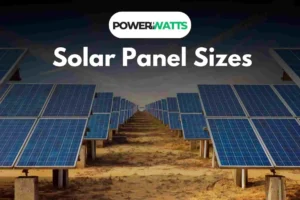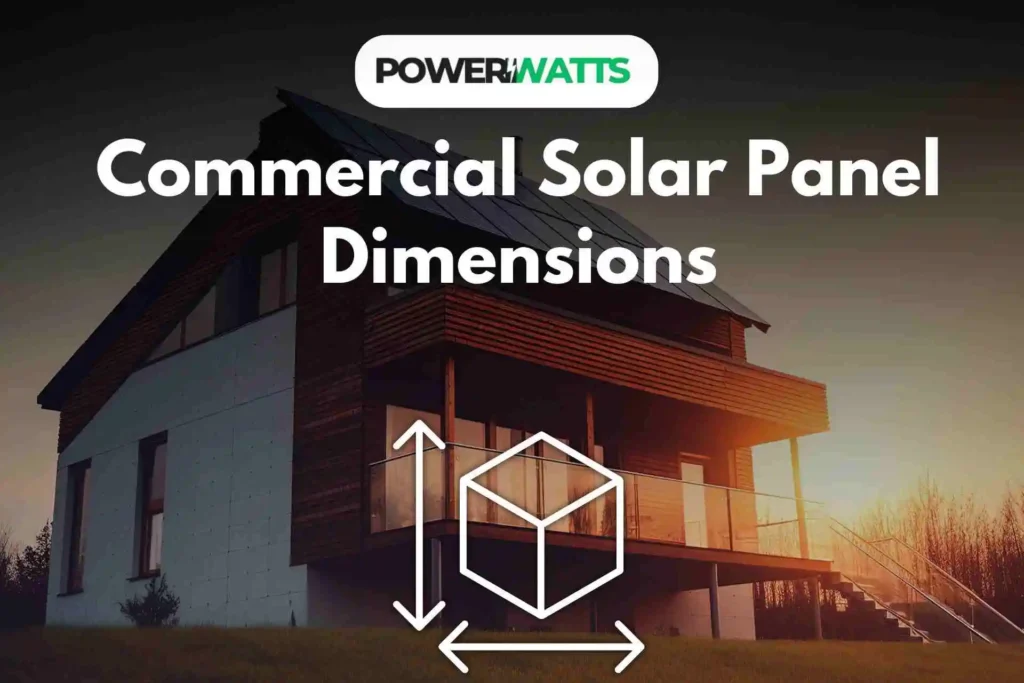Solar panels are a popular power source as the global energy landscape shifts towards renewable sources. Solar panels’ energy production and installation feasibility depend on their size.
The size of solar panels depends on the number of cells. The most frequent settings are 60- and 72-cell panels. An average 60-cell solar panel is 39 inches by 66 inches, whereas a 72-cell panel measures 39 by 77 inches. The number of panels needed to satisfy energy consumption depends on these dimensions also particularly for commercial installations. In the blog, we will discuss the commercial solar panel’s dimensions and the commercial solar panel’s calculation.
Standard Commercial Solar Panel Size
If you’re thinking about getting solar panels for your business, it’s important to know commercial solar panel dimensions. Most of the time, there are two types:
- Panels with 60 cells: These panels are usually 39 inches wide and 66 inches long. They are often used in homes but you can also find them in smaller business settings.
- Solar panels with 72 cells: These panels are 39 inches wide and 77 inches tall, which is a little bigger. Because they produce more energy, they are often chosen for business setups. 72-cell dimensions are best for commercial solar panels.
There are also 96-cell screens, which are less popular but measure about 41.5 inches by 62.6 inches. The main places where these panels are used are in business settings with a lot of room. It is important to know these sizes when planning setups because the size of the solar array has a direct effect on the amount of energy it produces.

Commercial Solar Panel Dimensions:
Understanding solar panel measurements is important for estimating how many panels can fit on commercial solar panels. Here are the average dimensions of the most typical solar panels.
60-cell Panel
- Width: 39 inches.
- Length: 66″
- Area: 17.62 square feet.
72-cell Panel
- Width: 39 inches
- Length: 77″
- Area: 21.13 square feet.
96-cell Panel
- Width: 41.5 inches
- Length: 62.6 inches
- Area: 17.5 sq. ft.
These measurements may vary somewhat depending on the manufacturer, but they serve as a reliable basis for installation planning.
Weight of Commercial Solar Panels
Solar panels can weigh anywhere from 40 to 60 pounds, based on the type and materials used. Most of the time, it is between 1.3 and 1.6 inches thick. When thinking about how strong the roof or fixing system is these things are important.
Commercial Solar Power Calculation Formula
Finding the best amount of solar panels for a business placement means figuring out how much energy is needed and dividing that number by the output of the panels being considered. The following method can be used to do this:
To find the number of panels, divide the total amount of energy needed (in kWh) by the number of hours of sunlight.
Let’s break down the formula:
- Total Energy Requirement is the amount of energy that the business needs to run. It is usually given in kilowatt-hours (kWh).
- The amount of power that each solar panel produces is called its “panel output.” This is generally given in kilowatts (kW). Around 250 to 400 watts is the power range for most business solar cells.
- The amount of peak sunshine hours that the panels will get each day in a certain place is called “Sunlight Hours.”
As an example, let’s say a company needs 10,000 kWh per month and has 300-watt (0.3 kW) panels that get five hours of sunlight a day on average. This is how the maths works:
- Output per month = (0.3 kW) x (5 hours) x (30 days) = 45,000 Wh, or 45 kWh
- Number of Panels = (10,000 kWh) / (45 kWh) = 222 panels
This estimate shows how important it is to know both how much energy is needed and how big the panels are to have a good and efficient business solar system. And if you are not sure about these systems then Get a Quote.
Factors that Affect Solar Panel Output
Several things can affect how much power solar panels produce, such as
- Orientation and tilt: The point at which solar panels are put in place can have a big effect on how well they work. It is best for the panels to face south (in the Northern Hemisphere) and be tilted at an angle that matches the site’s location.
- Shade: Trees, buildings, and other things that block the sun can make the panels less productive by blocking some of the sun’s rays.
- Temperature: Solar panels work better when it is cooler outside. They work less well in hot weather, so it’s important to think about the weather where you’ll be installing them.
- What Kind of Solar Panel: Monocrystalline, polycrystalline, and thin-film solar panels all work in different ways and need different amounts of room. In general, monocrystalline screens work better, but they cost more.
- Maintenance: Cleaning and fixing solar panels on a regular basis can help them work well for a long time. On the surface, dust, dirt, and other things can build up and block the sun.
Conclusion
Anyone contemplating solar energy systems must know commercial solar panel dimensions. Energy output and installation panel count depend on panel size. You may choose 60-cell and 72-cell panels that meet your energy demands by learning about their typical dimensions and performance parameters.
The appropriate solar panel size may save energy and cut carbon emissions. Consider your energy needs, space, and panel size before adopting solar. The size of solar panels determines how many may fit on your roof or land also affecting solar energy system effectiveness. Get a Quote now to move towards sustainable energy.


